IASbaba's Daily Current Affairs Analysis
Archives
(PRELIMS & MAINS Focus)
Syllabus
- Prelims – Governance
Context: The News Broadcasting & Digital Standards Authority (NBDSA), a self-regulatory agency set up by news and digital broadcasters, has fined a news channel for turning a news debate on hijab into a “communal issue” and not adhering to guidelines.
About News Broadcasting & Digital Standards Authority (NBDSA):
- The NBDSA is an independent body set up by the News Broadcasters & Digital Association (NBDA), which serves as a representative of private television news, current affairs and digital broadcasters.
- Funded entirely by its members, the NBDA has 26 news and current affairs broadcasters (comprising 119 news and current affairs channels) as its members.
- Various senior members of Indian media organisations serve on its Board of Directors.
- Apart from presenting a unified front, it carries out activities to promote, protect and secure the interests including the right of freedom of speech and expression of the news broadcasters, digital news media and other related entities.
Functions and Powers:
- It’s standards mention a focus on objectivity, impartiality, maintaining discretion when reporting on crime against women and children, not endangering national security, etc.
- The body includes a chairperson who is to be an eminent jurist, and other members such as news editors, and those experienced in the field of law, education, literature, public administration, etc. nominated by a majority of the Board.
- The Authority may initiate proceedings on its own and issue notice or take action in respect to any matter which falls within its regulations.
- This can also be through complaints referred to the Authority by the Ministry of Information & Broadcasting or any other governmental body, or by anyone else via its website
- A “two-tier” procedure is in place for redressing grievances, where any person aggrieved by the content of any broadcast is required to first make a complaint to the concerned broadcaster and if they are not satisfied by the redress, a complaint can be filed before the Authority.
- Within 14 days from the date of receipt of a complaint, the Authority will issue notice to the concerned broadcaster to show cause why action should not be taken under the regulations.
- An inquiry is held in which proof, documents, and people can be called in by the authority.
- If the complainant or the respondent does not get back to the Authority, the complaint can be set aside.
- It can also recommend to the concerned authority for suspension/revocation of the license of such broadcaster.
- The fine imposed by the Authority shall not exceed Rs. 1 lakh and such fine shall be recovered from the concerned broadcaster.
Source: Indian Express
Syllabus
- Prelims – History and art and culture
Context: The gurdwara management bodies from both sides of the border — Amritsar-based Shiromani Gurdwara Parbandhak Committee (SGPC) and Pakistan Sikh Gurdwara Parbandhak Committee (PSGPC) will jointly observe the centenary of Shaheedi Saka Panja Sahib (martyrdom massacre), at Hasan Abdal city of Attock district, Punjab province of Pakistan.
About Saka Panja Sahib:
- On October 30, 1922 two Sikhs died and several other Sikh protesters, including women, were injured at Hasan Abdal railway station after the railway authorities under the then-British government had refused to stop the train ferrying Sikh prisoners from Amritsar to Attock.
- The Sikhs from nearby Panja Sahib wanted to serve langar (community kitchen food) to the Sikh prisoners but were told by the station master that the train would not stop at the station.
- In protest, the Sikhs squatted on the railway tracks and as the train approached, the Sikhs, who were determined to halt the train, continued to stay put, demanding their right to serve langar to the Sikh prisoners.
- The train finally came to a screeching halt, but only after crushing many of Sikh protesters — of whom Bhai Karam Singh and Bhai Partap Singh died after sustaining serious injuries.
- Since then, both Sikhs are hailed as martyrs of Saka Panja Sahib who sacrificed their lives fighting for rights of Sikhs against the British.
About Gurdwara Panja Sahib:
- The Gurdwara Panja Sahib, in Hasan Abdal of Pakistan was built on the site believed to be visited by Sikhism’s founder Guru Nanak Dev, along with his companion Bhai Mardana.
- It is believed that a local saint Wali Qandhari was rude towards Nanak and refused to give water to Bhai Mardana who was extremely thirsty, from a natural fountain near his dera.
- He also threw a boulder towards Nanak, but Nanak stopped it with his panja (hand) and a spring of water appeared there miraculously.
- The boulder with Nanak’s handprint is still there.
- Later Maharaja Ranjit Singh and his general Hari Singh Nalwa got the gurdwara building constructed to commemorate Nanak’s visit.
Source: Indian Express
Syllabus
- Prelims – History and Art and Culture
Context: U.P. promotes tombs of Muslim devotees of Krishna for tourism
About Taj Bibi:
- She was born in the 17th century.
- Taj Bibi’s father’s name was Padna Khan.
- Taj Bibi, also known as the ‘Mughal Mirabai’, was the daughter of a Muslim nobleman, appointed by the Mughals to protect the Gokul area.
- Taj Bibi was married to Emperor Akbar.
- Emperor Akbar had great reverence for Gusain Shri Vitthalnath Ji and he used to come to Govardhan from time to time to have darshan of Gusain Ji.
- Once Taj Bibi came to Govardhan to see Gusain Ji with permission from Akbar.
- Taj Bibi returned to Delhi after a few days as per Akbar’s orders.
About Raskhan:
- Syed Ibrahim Khan (1548-1628) was an Indian Sufi Muslim poet who became a devotee of the Hindu deity Krishna.
- Raskhan was his takhallus (pen name) in Hindi.
- He accepted Krishna as the supreme god (Svayam Bhagavan) and became a Vaishnava.
- He died in 1628 AD.
- His samadhi is at Mahaban, about six miles east of Mathura.
- He translated Bhagavata Purana into Persian.
- The poetry of Raskhan focuses on Lord Krishna.
- Rachnavali is the collection of Raskhan’s poetry
- His poetry is in the form of Doha, Padawali and Savayya.
- Raskhan’s Khariboli writings are numerous, the five most important being the Sujana Raskhana, the Premavatika, the Danalila, the Astayama and a collection of Padas (rhymed couplets).
Source: The Hindu
Syllabus
- Prelims – History and art and culture
Context: The Prime Minister of India will pay tribute to the unsung heroes of the Bhil tribal community, during his visit to the Mangarh Dham in Rajasthan’s Banswara district.
About Mangarh Dham:
- Mangarh Dham is known for the massacre of tribals that took place six years before Jallianwalla Bagh and is sometimes referred to as the “Adivasi Jallianwala”.
- British forces killed hundreds of Bhil tribals on November 17, 1913, in the hills of Mangarh on the border of Rajasthan and Gujarat.
- It is located in the district on the Gujarat-Rajasthan border, a region with a large tribal population.
- Social reformer Govind Guru led the gathering of tribals and forest dwellers in 1913 in Mangarh against the British Raj.
About Bhils Tribal group:
- The word Bhil is derived from “Veel”, which means “bow” in the Dravidian language.
- The Bhil tribe is called “Dhanush Purush of India” because they are highly adept at learning Dhanush.
- Bhils are a group of tribal Indians scattered throughout India from Gujarat in the west to Tripura in the Far East.
- As of 2013, they were the largest tribal group in India with the majority living in the states of Gujarat, Madhya Pradesh, Rajasthan and Chhattisgarh.
- Bhils have a rich and unique culture. The Bhilala subdivision is known for its Pithora painting.
- Ghoomar is a traditional folk dance of the Bhil tribe.
- Ghoomar is the symbol of femininity.
- The young women take art in this dance and declare that they are stepping into women’s shoes.
Source: Indian Express
Previous Year Question
Q.1) With reference to the history of India, “Ulgulan” or the Great Tumult is the description of which of the following events? (2021)
- The Revolt of 1857
- The Mappila Rebellion of 1921
- The Indigo Revolt of 1859 – 60
- Birsa Munda’s Revolt of 1899-1900
Syllabus
- Prelims – Places in news (Geography)
Context: The first formal African Union-led peace talks between an Ethiopian government team and Tigray forces are happening in South Africa.
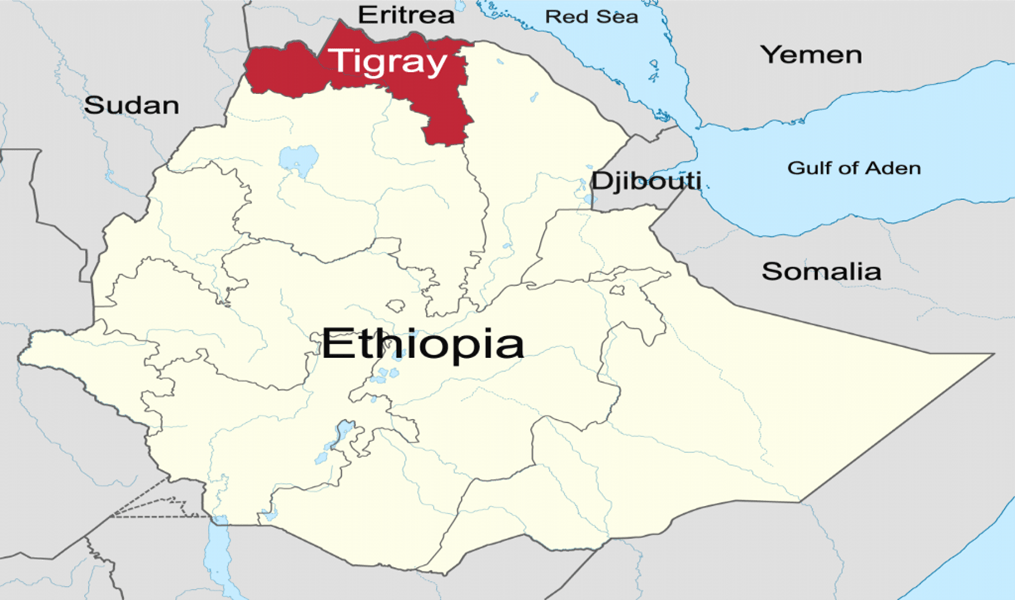
Important Events of Tigray Conflict:
1975:
- The ‘Derg’, a Soviet-backed Marxist military dictatorship led by Mengistu Haile Mariam was established in Ethiopia
- The Tigray People’s Liberation Front (TPLF) was formed as a small ethno-nationalist paramilitary group and a political outfit
1988: Ethiopian People’s Revolutionary Democratic Front (EPRDF) was founded and ruled for nearly three decades.
1991: Derg was ousted.
2020:
- The Ethiopian government began military operations in the Tigray region against the region’s ruling party, the TPLF.
- Civilian structures in towns in Tigray, including hospitals, schools, factories, and businesses, were shelled, looted and destroyed by Ethiopian federal forces and by Eritrean armed forces.
Source: The Hindu
Previous Year Question
Q.1) Consider the following pairs:
Region often mentioned in the news: Country
- Anatolia Turkey
- Amhara Ethiopia
- Cabo Delgado Spain
- Catalonia Italy
How many pairs given above are correctly matched? (2022)
- Only one pair
- Only two pairs
- Only three pairs
- All four pairs
Syllabus
- Prelims – Environment
Context: Recently, the government has restricted use of Glyphosate and its derivatives, fearing health hazards and risk to human beings/animals. The new rules permit only pest control operators to apply glyphosate. Pest control operators are licensed to use deadly chemicals for eliminating pests like rodents.
About Glyphosate:

- Glyphosate is an herbicide applied to the leaves of plants to kill both broadleaf plants and grasses. The sodium salt form of glyphosate is used to regulate plant growth and ripen specific crops.
- Glyphosate and its formulations are widely registered and currently used in more than 160 countries, including the EU and the USA.
- Farmers across the globe have been using it for safe and effective weed control for over 40 years.
- Its usage became popular in the country after the illegal cultivation of Ht BT cotton
- It is mainly used in tea plantations to control the growth of unwanted plants. It is also used in non-crop areas to prevent plant growth.
Risk Factors of using Glyphosate:
- Glyphosate is being banned because of its potential link to cancer in humans, as well as potentially causing the death of important insects, such as bees.
- Biologists have sounded the alarm over the serious decline in insect populations that affect species diversity.
Source: The Hindu
Previous Year Questions
Q.1) With reference to polyethylene terephthalate, the use of which is so widespread in our daily lives, consider the following statements:
- Its fibres can be blended with wool and cotton fibres to reinforce their properties.
- Containers made of it can be used to store any alcoholic beverage.
- Bottles made of it can be recycled into other products.
- Articles made of it can be easily disposed of by incineration without causing greenhouse gas emissions.
Which of the statements given above are correct? (2022)
- 1 and 3
- 2 and 4
- 1 and 4
- 2 and 3
Q.2) Which of the following are the reasons/factors for exposure to benzene pollution? (2020)
- Automobile exhaust
- Tobacco smoke
- Wood burning
- Using varnished wooden furniture
- Using products made of polyurethane
Select the correct answer using the code given below:
- 1, 2 and 3 only
- 2 and 4 only
- 1, 3 and 4 only
- 1, 2, 3, 4 and 5
Syllabus
- Prelims – Art and Culture
- Mains – GS 1 (History and art and culture)
Context: Recently coinage with images of gods and goddesses dates back to the Kushans has been found.
About Kushana Empire:
- Origin: The Kushans were one of five branches of the Yuezhi confederation, an Indo-European nomadic people.
- Yuezhis are people that ruled over most of the northern Indian subcontinent, Afghanistan, and parts of Central Asia during the first three centuries.
- In India: The Yuezhi nomads later transformed themselves into a ruling elite in a large area from Afghanistan to the Indus Valley and North Indian Plain.
- Role of Kanishka: Kanishka is considered to be the greatest king of the Kushan dynasty that ruled over the northern part of the Indian subcontinent, Afghanistan, and possibly areas of Central Asia north of the Kashmir region.
- He is, however, chiefly remembered as a great patron of Buddhism.
- Great Eurasian power:
- It was during his reign, the kingdom was acknowledged as one of the four great Eurasian powers of its time (the others being China, Rome, and Parthia).
- Shaka Era:
- The year 78 marks the beginning of the Shaka era, a system of dating that Kanishka might have initiated.
- Satrapy system in India:
- Kushanas adapted the Persian satrapy administrative system into Indian kshatrapa administration.
- The Kushan regime gave much autonomy to local institutions such as castes, guilds, and Buddhist monasteries and meanwhile won support from those local communities.
- Trade with Rome:
- The Kushans became affluent through trade, particularly with Rome, as their large issues of gold coins show.
- The Kushan Empire benefited from the Silk Road trade economically and meanwhile received the knowledge of faraway countries and facilitated transferring the information to the visions of the Romans, Parthians, and Chinese.
- Buddhism and art schools in India:
- The Kushans were instrumental in spreading Buddhism in Central Asia and China and in developing Mahayana Buddhism and the Gandhara and Mathura schools of art.
- Legacy:
- Unfortunately, very little evidence of the Kushan rule survives today.
- In this, Kushan coins are perhaps the best evidence we may have of this illustrious dynasty.
About the Kushana Coins
Kadaphises:
- It was the Kushan emperor, Vima Kadaphises who introduced the first gold coins of India.
- The Double Dinar can be considered as the first gold coin of the Indian subcontinent.
- He introduced gold and copper coins, a large number of them have survived till today.
Kanishka:
- Kanishka minted coinage in two metals, gold and copper.
- Gold coins were minted in two denominations; Dinar (or stater) and quarter Dinars.
- Undoubtedly, Kushana coins were influenced by their predecessors Indo-Greeks, who were overthrown by Kushanas.
Images on the Kushana Coins:
Gods:
- The coins exhibit the figures of Greek, Roman, Iranian, Hindu, and Buddhist deities.
- According to historians, Kushanas were the first to use the image of Goddess Lakshmi on their coins, along with Ardochsho, the Iranic Goddess of wealth.
- They also depicted Oesho (Shiva), moon deity Miro and Buddha in their coinage.
Kings:
- Kushan coins tell a great deal about the images of the kings as they wished to be seen by their subjects.
- The portraits on Kushana gold/copper coins of Vima Kadphises are amazingly individualistic, often showing him full-bearded, big-nosed, fierce looking warrior chieftain, perhaps with deformed skull, wearing.
- high helmet, tunic, overcoat and felt boots.
About Coins in India:
The beginning: The Coinage of India began anywhere between early 1st millennium BCE to the 6th century BCE, and consisted mainly of copper and silver coins in its initial stage.
- The coins of this period were Karshapanas or Pana.
Satavahana:
- The dates of their coming into power are contentious and are variously put between 270 BC to 30 BC.
- Their coins were predominantly of copper and lead; however, silver issues are also known.
- These coins carried the motifs of fauna like elephants, lions, bulls, horses, etc. often juxtaposed against motifs from nature like hills, tree, etc.
- The silver coins of the Satavahanas carried portraits and bilingual legends, which were inspired by the Kshatrapa types.
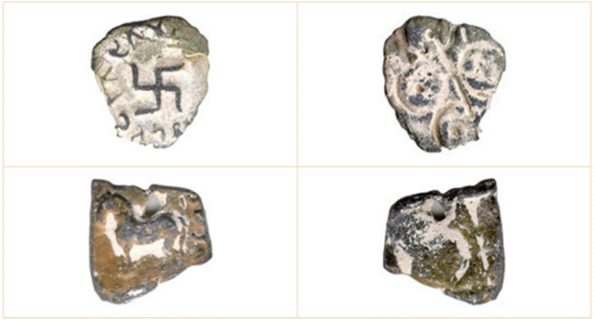
Western Kshatrapa:
- The legends on the coins were generally in Greek and Brahmi, Kharoshti too was used.
- The Western Kshatrap coins are reckoned to be the earliest coins bearing dates.
- The common copper coins are the ‘bull and hill’ and the ‘elephant and hill’ types.
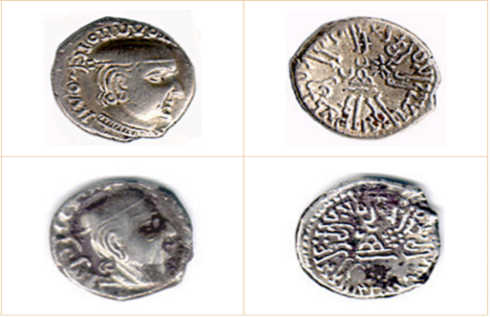
South Indian Coinage:
Cheras:
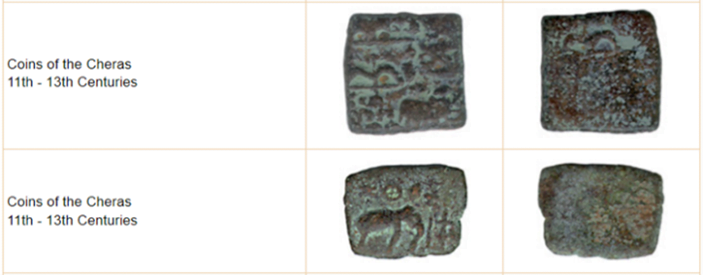
Cholas:

India has a long tradition of coinage with images of gods and goddesses
Dynasties with gods on their coins in India:
Gupta Coins:
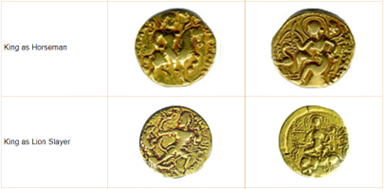
- The Gupta Empire produced large numbers of gold coins depicting the Gupta kings performing various rituals.
- The splendid gold coinage of the Guptas, with its many types and infinite varieties and its inscriptions in Sanskrit, are the finest examples of the coinage that we possess.
Vijayanagara Kings:
- Vijayanagara kings used coinage with Hindu idols. Harihara –II (1377-1404) introduced coins that had Brahma-Saraswati, Vishnu-Lakshmi and Shiva-Parvati.
- The Vijayanagara coins continued in circulation even after the kingdom was snuffed out in 1565 and commanded a premium when French traveller Tavernier visited the region.
The British East India Co.:
- The British East India Co. at Madras Presidency minted coins labelled as the Three Swamy Pagoda, which depicts Lord Balaji flanked by Sridevi and Bhudevi on either side.
- Not all the coins were freshly minted. Some were repurposed. Some were issued to show continuity.
Other Coins:
- Ancient India had considerable trade links with the Middle East, Europe (Greece and Rome) as well as China. This trade was carried out over land partly along what came to be alluded to as the silk route and partly through maritime trade.
- In South India, which had a thriving maritime trade, Roman coins even circulated in their original form, albeit slashed at times as a gesture disclaiming intrusions of foreign sovereignty.
Source: The Hindu
Syllabus
- Mains – GS 2 (Governance)
Context: The Farmers (Empowerment and Protection) Agreement on Price Assurance and Farm Services Act, 2020 is an important legislative landmark in the context of Indian agricultural policy.
- The dramatic repeal of the three controversial farm laws in November 2021 provided a unique opportunity for policymakers to critically examine the calls for reforming India’s agricultural marketing regulatory framework from a stakeholder point of view.
- A study critically examines the various provisions contained in the act to assess its potential in mitigating the key concerns of adopting the CF practice in India.
About contract farming:
- Contract farming can be defined as agricultural production carried out according to an agreement between a buyer and farmers, which establishes conditions for the production and marketing of a farm product or products.
- Typically, the farmer agrees to provide agreed quantities of a specific agricultural product. These should meet the quality standards of the purchaser and be supplied at the time determined by the purchaser.
Regulatory structure on contract farming in India:
- Initially, contract farming regulated under the Indian Contract Act, 1872.
- The Model APMC (Agricultural Produce Market Committee) Act, 2003 provides specific provisions for contract farming, like compulsory registration of contract farming sponsors and dispute settlement.
- However, due to resistance from commission agents, States were lukewarm towards promoting Contract farming.
- In 2004, the MS Swaminathan-headed National Commission on Farmers (NCF) recommended the design and implementation of a comprehensive code of conduct on contract farming.
- The National Policy for Farmers 2007, based on the recommendations of NCF, also encouraged Contract farming practices and promised to prepare a code of conduct for contract farming.
- In February 2018, Ministry of Agriculture came out with a draft Model Contract Farming Act, 2018. The draft Model Act seeks to create a regulatory and policy framework for contract farming. Based on this draft Model Act, legislatures of states can enact a law on contract farming
- Currently, contract farming requires registration with the Agricultural Produce Marketing Committee (APMC) in few states. This means that contractual agreements are recorded with the APMCs which can also resolve disputes arising out of these contracts.
Benefits of Contract farming:
Contract farming is looking towards the benefits both for the farm-producers as well as to the agro-processing firms. The key advantages are the
- Crop diversification;
- Higher crop yield;
- Reduction in price uncertainty;
- Better price and assured market for farmers;
- Increase in profit and income of farmers;
- Supply of quality farm inputs,
- Including farm credit technology and scientific know-how to farmers;
- Reduction in transportation costs;
- Growth of food processing industry;
- Integration of farmers into the industry and global market.
Disadvantages of Contract farming:
Some of the key disadvantages of Contract farming practices are:
- Neglect of small and marginal (S&M) farmers by firms,
- Dominant role by firms in price fixation,
- Delay in making payments to farmers,
- Non-purchase of contracted produce on quality and other grounds,
- Manipulation of grading standards,
- Breaking away from contracts by either party,
- Difficulty of legal enforcement of contracts,
- Lower long-term commitment among corporates for rural development.
Challenges:
- Contract farming arrangements are often criticized for being biased in favour of firms or large farmers, while exploiting the poor bargaining power of small farmers.
- Problems faced by growers like undue quality cut on produce by firms, delayed deliveries at the factory, delayed payments, low price and pest attack on the contract crop which raised the cost of production.
- Contracting agreements are often verbal or informal in nature, and even written contracts often do not provide the legal protection in India that may be observed in other countries.
- Lack of enforceability of contractual provisions can result in breach of contracts by either party.
- Single Buyer – Multiple Sellers (Monopsony).
- Adverse gender effects – Women have less access to contract farming than men.
Stakeholders views on contract farming:
- In the CF system, firms largely ignore smallholders to achieve economies of scale and reduce transaction costs.
- Therefore, the CF Act has opened the avenue for collective engagement among farmers with a provision to engage aggregators, including FPOs (Farmer Producer Organisations), in CF.
- A predominant section of the stakeholders surveyed, including three-fourths of the farmers, believed that the collectivisation of farmers through FPOs would help smallholders adopt CF.
- Three-fourths of the stakeholders supported the inclusion of these quality-related provisions in the CF legislation.
- However, farmers suggested arranging quality inspection in their presence and a scheme for educating them on quality standards.
- There are fears that the firms will exploit farmers in many ways, such as denying a say in price fixation, grabbing farmers’ land, and treating farmers as bonded labourers.
- The CF Act stipulates that farmers can opt for a contract for one crop season or a mutually agreeable period. This provides freedom for farmers to change their choice of firms.
- Over half of the respondents, including farmers, agreed that a shorter contract period would enable farmers to escape exploitation by the firms.
- The CF Act stipulates that the prices may be determined in advance and indicated in the contract. If prices fluctuate, the agreement must include a guaranteed and reference/benchmark price.
- Compulsory registration would encourage written agreements and the entry of only serious players.
- Another suggestion supported by three-fourths of the stakeholders was the levy of a small facilitation fee on the firms and establishing a dedicated official agency to oversee and facilitate the working of the CF Act.
- The agency was expected to handhold the farmers through training and capacity-building programmes using the fee proceeds and bridge the trust deficit between farmers and firms.
Way Forward:
- The contract farming seeks to provide alternative marketing channels and better price realisation to farmers.
- It has been observed that if the market price rises higher than the contracted price, the farmers are tempted to sell the produce to someone else for a higher price.
- On the other hand, if market prices were to fall below the contracted rate, the buyer often fails to honour the commitment.
- It is also necessary to remember that for growers agriculture is a livelihood issue and for processors and aggregators it is business.
Hence the Government should play the role of a facilitator to promote as well as to develop a healthy system of farmer-corporate relationship for mutual benefit and development of the agriculture sector in India.
Source: The Hindu
Syllabus
- Prelims – Science and Technology
- Mains – GS 3 (Science and Technology)
Context: The key aspects of safety and sustainability are posing impediments to the growth envisaged in lithium-ion battery (LIB) usage. In India, reports of fatality and material loss due to fire from LIBs are on the rise.
About Li ion batteries (LIB):
- Lithium-ion batteries use aqueous electrolyte solutions, where ions transfer to and fro between the anode (negative electrode generally made of graphite) and cathode (positive electrode made of lithium), triggering the recharge and discharge of electrons.
Features of LIB:
- Small size of the batteries
- light weight
- affordability
- the ability to sustain multiple charge cycles
- high energy density
Various impediments to the growth of LIB:
Safety issues with LIB:
In India, reports of fatality and material loss due to fire from LIBs are on the rise due to defects in battery cells as well as in battery designs.
Concerns around sustainability and lifecycle management of LIBs:
- The challenge of the ever increasing demand for metals required for the batteries and the mines as the only primary mineral source.
- Environmentally sustainable solutions to deal with the mountains of garbage created by end-of-life batteries.
Challenge of Partial recovery of metals from recycling processes:
- Most recycling processes practise partial recovery wherein only high-margin metals are recovered from waste discarding the rest resulting in a loss of economic opportunity for the nations which continue to rely on high-cost imports.
- It also provides little economic incentive for other recyclers to recover low-margin metals from the discarded waste.
Ensuring sustainability and lifecycle management of LIBs:
- According to predictions, the volume of the end-of-life LIBs is likely to increase from 7,05,000 tonnes in 2025 to about 9 million tonnes by 2040.
- As the long-term sustainability of depending on primary mineral sources (mines) is in question, recycling is key.
- Unlike traditional practices, design of EVs is integrated with that of the battery and its components.
- The customisations on the battery end get more complex with new features like swappable battery options and connectivity requirements as in the case of autonomous cars.
- EVs therefore need an accelerated go-to-market approach to cater to the sustainability goals driven by organisations and nations across the world.
Government Measures to mitigate the environmental, social and financial impacts of LIB waste:
- The government has notified the Battery Waste Management Rules 2022 to manage a wide range of batteries that include LIBs.
- The mechanism of “Extended Producer Responsibility” (EPR) increases the accountability battery manufacturers need to assume towards collection, refurbishment/recycling of batteries.
- This move is expected to accelerate the development of infrastructure for waste collection and improve recycling rates from the mere 5-9 per cent, as it stands today.
Way Forward:
- A mandated minimum percentage of recycled material in all products will open doors for new technologies to be adopted.
- Thus, the need of the hour is to accelerate the development of circular economy solutions that recycle all the metals and facilitate a cradle-to-cradle (infinite loop) approach.
- The ultimate goal is to meet sustainability goals and deploy technologies/best practices that reduce dependency on primary ores and unless that is done, partial recovery of metals or export of black powder (crushed battery waste) for recovery will continue.
- A strong collaboration among technologists, policy-makers and governments is required to help manage the ‘EV revolution ‘and bridge the huge gap between technology readiness that addresses both sustainability and safety issues in LIBs.
Source: The Hindu
Daily Practice MCQs
Q.1) Consider the following statements regarding Mangarh Dham and Bhils:
- Ghoomar is a traditional folk dance of the Bhil tribe
- As of 2013, they were the largest tribal group in India with the majority living in the states of Gujarat, Madhya Pradesh, Rajasthan and Chhattisgarh
- Mangarh Dham is known for the massacre of tribals including bhils that took place six years before Jallianwalla Bagh and is sometimes referred to as the “Adivasi Jallianwala”.
Which of the above are correct?
- 1 and 2 only
- 2 and 3 only
- 1 and 3 only
- 1 2 and 3
Q.2) The Tigray conflict region is often mentioned in news is related to
- Ukraine
- Egypt
- Ethiopia
- Mexico
Q.3) With reference to cultural history of India, consider the following statements:
- The Kushans were instrumental in developing Gandhara and Mathura schools of art.
- Vima Kadaphises introduced the first silver coins of India.
- The Western Kshatrap coins are reckoned to be the earliest coins bearing dates.
- The Vijayanagara coins continued in circulation even after the kingdom was snuffed out in 1565.
Which of the statements given above are correct?
- 1 3 and 4 only
- 1 2 and 4 only
- 2 and 3 only
- 1 and 4 only
Comment the answers to the above questions in the comment section below!!
ANSWERS FOR ’29th October 2022 – Daily Practice MCQs’ will be updated along with tomorrow’s Daily Current Affairs.st
ANSWERS FOR 28th October – Daily Practice MCQs
Q.1) – a
Q.2) – c
Q.3) – b












